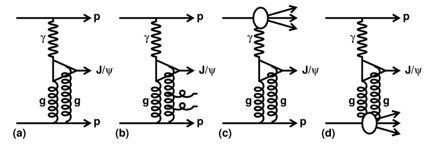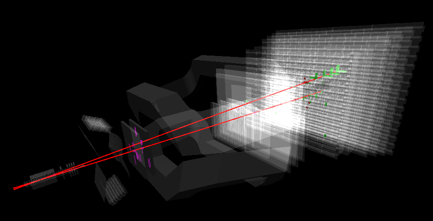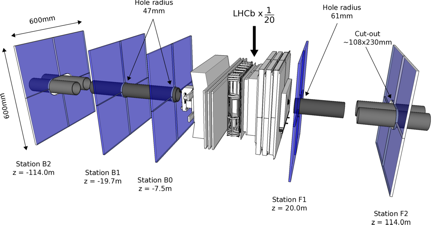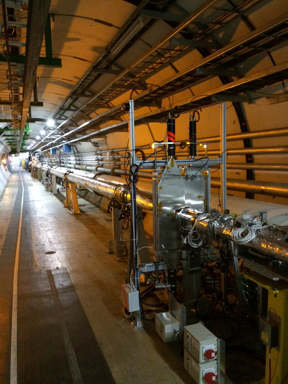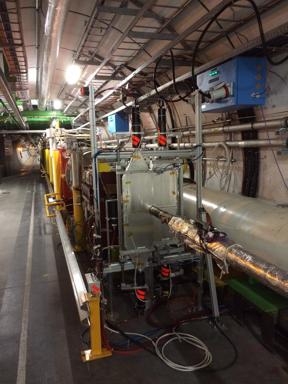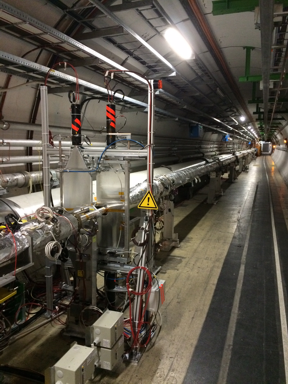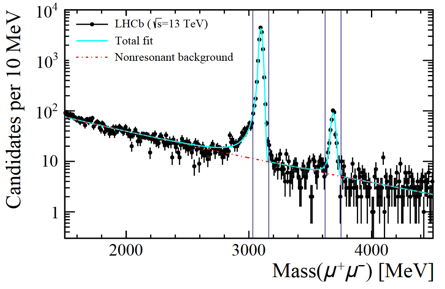First physics results with the HeRSCheL detector.
In a typical proton-proton collision at the LHC, proton constituents, quarks or gluons, interact and move to opposite directions. They are interconnected by a strong interaction coloured field, a so-called “string”. (Note an analogy to the electromagnetic field interconnecting electric charges.) The strength of this interaction increases with distance until finally the string breaks (fragments) into many hadrons collimated into two or more directions forming in this way characteristic jets. The remaining proton fragments, made of quarks or gluons which did not interact, continue to move in the direction close to their original trajectory, also carrying colour quantum numbers. Therefore, a coloured string interconnecting the two proton remnants is also formed, which then fragments into a high number of particles. The distribution of these particles is close to flat in the (pseudo)-rapidity η, η=-ln(tan(Θ/2)), being Θ the angle between the particle trajectory and the beam line.
Sometimes LHC protons also scatter at small angle without producing additional particles. This kind of interactions is interpreted as being produced by the exchange of an object named pomeron, which has quantum numbers of the vacuum. This concept was introduced in the Regge theory of strong interactions, a very popular theory which enjoyed a period of interest in the 1960s, and was then largely superseded by QCD.
Pomerons, emitted by each proton, can also interact, producing in turn a small number of hadrons. Since pomerons are colourless, rapidity regions depleted of accompanying particles appear, named “rapidity gaps”. This kind of interaction can also be observed if one of the pomerons is replaced by a photon. In the QCD language, a pomeron is interpreted as a two-gluon exchange in which no overall colour charge is transmitted. The left image shows a set of possible Feynman diagrams producing a J/ψ meson with or without a small number of accompanying particles. This kind of processes is referred as a Central Exclusive Production (CEP). The left image below shows a spectacular example of CEP in which two muons from a Υ(1S)-meson decay are reconstructed by the LHCb detector without any other signal recorded.
The High Rapidity Shower Counters for LHCb (HeRSCheL) detector was built to enhance studies of this interesting physics. It is located in the LHC tunnel at a maximum distance of 114m, on either side of the LHCb interaction point (see right image above). The detector was built in 2014 and installed at the beginning of 2015. It consists of twenty square scintillator modules, each about 30×30 cm2 wide, in which tiny flashes of light are produced when they are traversed by charged particles. The scintillators are placed within centimetres of the LHC beam, just outside the vacuum pipe (see images below and video). They can therefore be used to detect particles produced by collisions at the LHCb interaction point, whose deviation from the beam direction is so small that they are not detected in the main LHCb apparatus but escape down the beam-pipe and only emerge further along the tunnel, near the HeRSCheL detectors. Somewhat counter-intuitively, then, a proton-proton interaction of interest is one that leads to nothing being detected by HeRSCheL! Indeed, these rare occurences correspond to CEP events where no particles are produced, except those from pomeron interactions. Thus absence of signal in HeRSCheL enables to be identified and removed very efficiently the much more abundant proton-proton interactions producing a significant number of hadrons.
The HeRSCheL detector is named after Caroline and William Herschel who, together, made great advances in the field of astronomy during the late 18th and early 19th centuries. Not unlike the work of the Herschel family, the HeRSCheL detector brings together well-known and well-established technologies in a novel application. In so doing, HeRSCheL provides a valuable extension to the LHCb physics programme.
Today the LHCb Collaboration submitted for publication first results of J/ψ and ψ(2S)-meson CEP in pp collisions at 13 TeV. The use of HeRSCheL allowed backgrounds and systematical uncertainties to be reduced significantly. Two muon tracks were clearly identified in the LHCb detectors. Events having additional activity, either in the form of charged or neutral particles observed in the LHCb detector as well as those with significant deposits in the HeRSCheL detector, were removed. The image shows clearly visible enhancements at the mass values of J/ψ and ψ(2S) mesons. The results are in agreement with theoretical calculations of two-meson production mainly through pomeron-photon interactions, the continuum being produced via photon-photon interactions. These results represent an excellent test of QCD, as well as an investigation of the nature of the pomeron, and also a means for constraining the gluon distribution in the proton (PDF) at low values of proton momentum fraction.
Read more in the LHCb paper, in the HeRSCheL performance paper and in the CERN Courier article.

